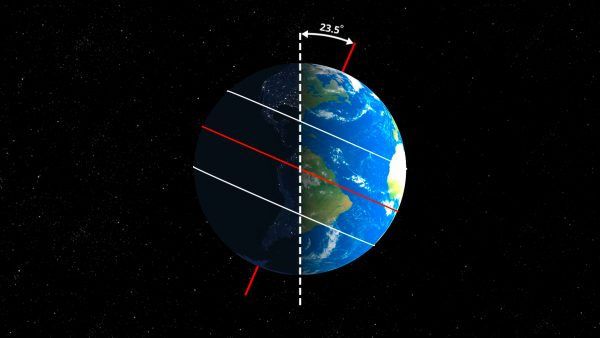Latitude Definition
Latitude measures distance north or south of the equator using imaginary east-west lines. For example, the equator is at 0° latitude.
View Lesson on Causes of Seasons
Become a member to get full access to our entire library of learning videos, reading material, quiz games, simple DIY activities & more.
Become a member to get full access to our entire library of learning videos, quiz games, & more.
Plans & Pricingto watch this full video.

Access All Videos
and Lessons, No Limits.
Access All Videos

No credit card required,
takes 7 sec to signup.
No card required

Ready-to-go lessons
that save you time.
Ready-to-go lessons
If you are on a school computer or network, ask your tech person to whitelist these URLs:
*.wistia.com, fast.wistia.com, fast.wistia.net, embedwistia-a.akamaihd.net
Sometimes a simple refresh solves this issue. If you need further help, contact us.
Causes of Seasons
Fun Facts
- The equator divides Earth equally into two hemispheres and is found at 0 degrees latitude.
- The Arctic Circle is found at a latitude of 66.5 degrees N, and the Antarctic Circle is found at 66.5 degrees S.
- The larger the degree of latitude, the longer the hours of daylight.
Why Do We Need To Know About Latitude
Learning about latitude helps us know why weather changes with seasons and why this is important for farming and city planning. Knowing how the strength of sunlight changes with latitude helps us put solar panels in the best places, making solar energy projects work better.
This knowledge also affects global trade and travel because different parts of the world have opposite seasons. It’s important for sending goods to other countries and for tourism.
Frequently Asked Questions
Check out the Full Lesson on Causes of Seasons
In this lesson, we learn that:
- Earth spins on its axis, which is tilted by 23.5 degrees.
- This tilt causes places on Earth to experience different intensities of sunlight at different times of year.
- That leads to changes in temperature, which results in seasons.
Related Topics
- Batteries Definition
- Biodiversity Definition
- Carbon Dioxide Definition
- Carnivore Definition
- Climate Definition
- Continental Drift Definition
- DNA Definition
- Definition Of Engineering
- Definition Of Nutrients
- Dissolve Definition
- Earth’s Axis Definition
- Earth’s Rotation Definition
- Energy Definition
- Engineering Design Process Definition
- Food Chain Definition
- Food Web Definition
- Fossil Definition
- Frequency Definition
- Gas Definition
- Genetic Factors Definition
- Greenhouse Gases Definition
- Hearing Definition
- Heat Definition
- Heating And Cooling Definition
- Inclined Plane Definition
- Invasive Species Definition
- Kuiper Belt Definition
- Latitude Definition
- Law Of Conservation Of Matter Definition
- Lever Definition
- Limited Resource Definition
- Liquid Definition
- Magnetism Definition
- Muscular System Definition
- Ocean Current Definition
- Opaque Definition
- Parasitism Definition
- Photosynthesis Definition
- Predation Definition
- Prey Definition
- Rain Definition
- Reproduction Definition
- Sedimentary Rock Definition
- Signal Definition
- Snow Definition
- Transform Boundary Definition
- Virus Definition
- Water Definition
Start a Free Trial Today. Get a $5 Amazon Gift Card!
Teachers! Start a free trial & we'll send your gift card within 1 day. Only cards left. Try it now.
Select Grade
Select Subject
This email is associated with a Science Kit subscription. Kit subscriptions are managed on this separate page: Manage Subscription

-
Download InvoiceScience & Math$/yr
-
Download InvoiceScience Only$/yr

access all lessons
• No credit card required •
"My students loved the videos. I started the video subscription in May and used them as a review before the state test, which I know contributed to 100% of my class passing the state test."
Rhonda Fox 4th Grade Teacher, Ocala, Florida
Use Generation Genius in Your School
Access all lessons free for 30 days.
"My students loved the videos. I started the video subscription in May and used them as a review before the state test, which I know contributed to 100% of my class passing the state test."
Rhonda Fox 4th Grade Teacher, Ocala, Florida
• No credit card required •
Already a member? Sign In
* no credit card required *

* no credit card required *
* no credit card required *


to Discover the Benefits of Generation Genius
Learn How to Save for Your School & District!

no credit card required
Skip, I will use a 3 day free trial
Enjoy your free 30 days trial
-
Unlimited access to our full library
of videos & lessons for grades K-5. -
You won’t be billed unless you keep your
account open past your 14-day free trial. -
You can cancel anytime in 1 click on the
manage account page or by emailing us.
-
Unlimited access to our full library of videos & lessons for grades K-5.
-
You won't be billed unless you keep your account open past 14 days.
-
You can cancel anytime in 1-click on the manage account page.
Cancel anytime in 1-click on the manage account page before the trial ends and you won't be charged.
Otherwise you will pay just $10 CAD/month for the service as long as your account is open.
Cancel anytime on the manage account page in 1-click and you won't be charged.
Otherwise you will pay $10 CAD/month for the service as long as your account is open.
We just sent you a confirmation email. Enjoy!
DoneWe use cookies to make your experience with this site better. By using this site you agree to our use of cookies. Click "Decline" to delete and block any non-essential cookies for this site on this specific property, device, and browser. Please read our privacy policy for more information on the cookies we use.Learn More
We use cookies to improve your experience. By using this site, you agree to our use of cookies. Click "Decline" to block non-essential cookies. See our privacy policy for details.Learn More




























































































































